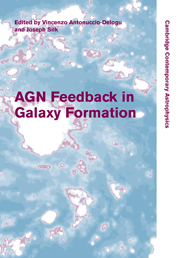Book contents
- Frontmatter
- Contents
- List of contributors
- Preface
- The organising committees
- Part I AGNs, starbursts and galaxy evolution
- 1 The effects of mass and star-formation timescale on galaxy evolution
- 2 Suppressing cluster cooling flows by multiple AGN activity
- 3 Starburst and AGN activity in Spitzer-selected sources at high-z
- 4 Star formation in galaxies hosting active galactic nuclei up to z ∼ 1
- Part II Co-evolution of black holes and galaxies
- Part III Outflows and radio galaxies
- Part IV Models and numerical simulations: methods and results
- Index
3 - Starburst and AGN activity in Spitzer-selected sources at high-z
from Part I - AGNs, starbursts and galaxy evolution
Published online by Cambridge University Press: 10 November 2010
- Frontmatter
- Contents
- List of contributors
- Preface
- The organising committees
- Part I AGNs, starbursts and galaxy evolution
- 1 The effects of mass and star-formation timescale on galaxy evolution
- 2 Suppressing cluster cooling flows by multiple AGN activity
- 3 Starburst and AGN activity in Spitzer-selected sources at high-z
- 4 Star formation in galaxies hosting active galactic nuclei up to z ∼ 1
- Part II Co-evolution of black holes and galaxies
- Part III Outflows and radio galaxies
- Part IV Models and numerical simulations: methods and results
- Index
Summary
Introduction
Some galaxy evolutionary models postulate that powerful starburst galaxies at high-z yield local massive galaxies following the effects induced by an accreting supermassive black hole (SMBH) at their centre (e.g. Di Matteo et al. 2005). However, it is not clear on which spatial and temporal scales and through which physical processes this transition takes place (see Coppin et al. 2008). Here, we investigate this evolutionary scenario by comparing star formation rates (SFRs), AGN activity and stellar masses in high-z (z ∼ 2) active systems.
Spitzer selection of high-z luminous infrared galaxies
For this work, we selected a sample of IR luminous source candidates in a ∼s20 deg2 area obtained by combining the Lockman Hole field (LH, ∼11 deg2, α = 10h 45m, δ = + 58°), and the XMM-LSS field (XMM, ∼9 deg2, α = 02h 21m, δ = −04° 30′) of the Spitzer Wide Area Infrared Extragalactic Survey (SWIRE; Lonsdale et al. 2003). Both fields benefit from multi-band ground-based optical (Ugriz) and Spitzer IR bands (seven bands from 3.6 to 160 μm). IR luminous sources, powered by star formation or AGN activity, are expected to be bright mid-infrared (MIR) sources. Powerful starburst galaxies are characterised by spectral energy distributions (SEDs) that are bright throughout the MIR to millimetre range. Luminous AGNs are bright MIR sources because their emission from AGN-heated dust peaks in the MIR. We thus selected all sources with a 24 μm flux > 400 μJy (corresponding to ≳ 5σ).
- Type
- Chapter
- Information
- AGN Feedback in Galaxy Formation , pp. 21 - 28Publisher: Cambridge University PressPrint publication year: 2010

